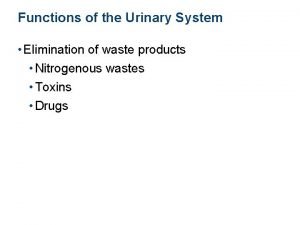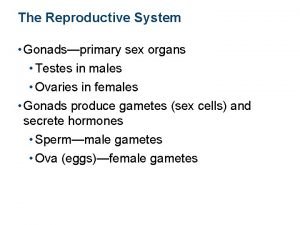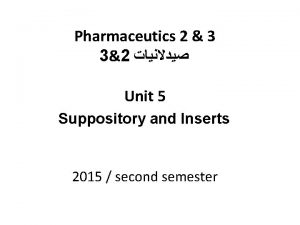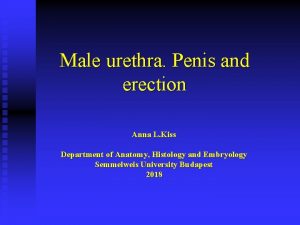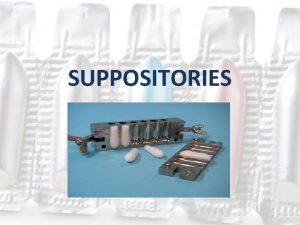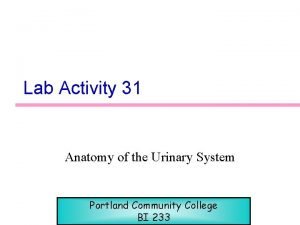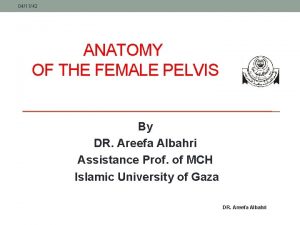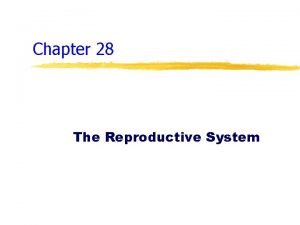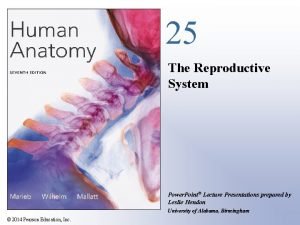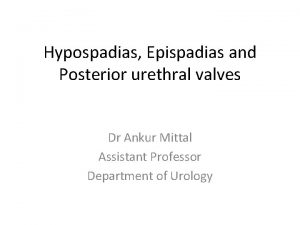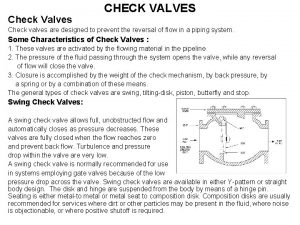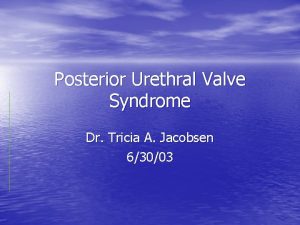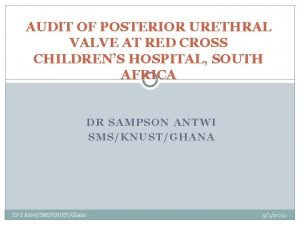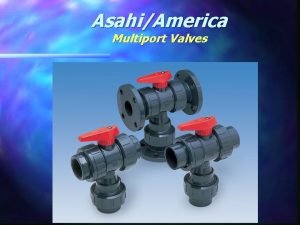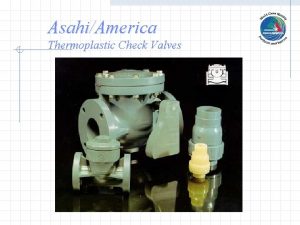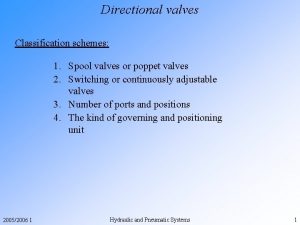Disorders of the urethra Posterior urethral valves The

















- Slides: 17

Disorders of the urethra

Posterior urethral valves • The most common obstructive lesions in infants & newborns, • occur mainly in males & are found at the distal prostatic urethra. • The valves are mucosal folds that look like thin membranes; they may cause varying degrees of obstruction when the child attempts to void

Classification • Type 1 (90 -95) valve extend from verumontanum to fuse anteriorly • Type 2 extending from verumontanum to bladder neck • Type 3 it ring like membrane found distal to verum. Diagnosis : q. Prenatal uls : bil. hydroureteronephrosis , dilated bladder and posterior urethra , oligohydromramnios renal dysplasia

q. Newborn and infants : Respiratory distress , palpable abdominal mass , ascites , failure to thrive q. Older children : recurrent UTI , weak stream , incomplete empty , incontinence. VUR Investigation: • uls • Voiding cystourethrogram : dilated post. Urethra , valve leaflet , thick Bladder neck • Isotope renal scan: assess function • Videourodynamics: to diagnose associated voiding dysfunction

Treatment: v. Bladder drainage • If boy born with suspected PUV then treat by drainage and if possible immediate VCUG • Drainage either by urethral catheterization suprapubic catheter v. Valve ablation When medical fitness is acheif and creatinine is normal then removing of valve by resectoscop v. Vesicostomy v. High diversion : used if bladder drainage is insufficient to drain the upper urinary tract

Urethral stricture Is an area of narrowing in the urethral calibre due to scar formation in the tissue surrounding urethra • it is either congenital or acquired, • most acquired strictures are due to: ØInflammation remains a major cause particularly infection from long term user of indwelling catheters. Ø External trauma • Straddle injury – blow to bulbar urethra • Iatrogenic – instrumentation

• Urethral strictures are fibrotic narrowing compose of dens collagen & fibroblasts • These narrowing restrict urine flow • The bladder muscle may become hypertrophic, & increased residual urine may be noted. • Sever prolong obstruction may lead to reflux, hydronephrosis, & renal failure • Urethral fistula & periurethral abscess commonly develop in chronic severe stricture.

Complications. • Chronic prostatitis, • cystitis, chronic UTI, • diverticula, • urethrocutaneous fistula, • periurethral abscess Vesicle calculi Clinical findings • Voiding symptoms – hesitancy, poor stream , post voiding dribbling, low flow rate • Urinary retention • UTI - prostatitis , epdidymitis

q. Investigation • Urethrogram: show location and lengh of stricture • Real-time uls • MRI Endoscopic examination Treatment. 1 - dilatation of the urethra is not usually curative, it fracture the scar tissue as the healing occur, the scar tissue reform. 2 - endoscopic urethrotomy. 3 - surgical reconstruction

Hypospadias ØHypo= below , spadon =orifice ØThe condition in which the urethral meatus opens on the ventral side of the penis proximal to the tip of the glans penis ØIncidence 1/250 It consist of 3 anomalies 1 - abnormal opening of the urethral meatus any where located from the ventral aspect of glans to perineum 2 - abnormal ventral curvature o penis (chordee) 3 - abnormal distribution of foreskin(hood)

Classification According to location: 1 - Anterior including: glandular, coronal and sub coronal 2 - Middle include distal penile, midshaft and proximal penile 3 -Posterior include penosecrotal, scrotal and perineal

Assessment • Patient with hypospdias should diagnosed at birth • Assess the associated anomaly like undescended testis , ingunal hernia • Severe hypospedious or hypospedious with uni or bilateral cryptoricdism or penosecrotal hypospedious should have chromosomal study to exclude intersexuality Treatment For psychological reasons hypospadias should be repaired before the patient reach the school age; in most cases this can be done before the age 2.

Epispadias • The urethra is displaced dorsally • Most females with epispadias are incontinent. • The pubic bone are separated as in exstrophy of the urinary bladder. • Treatment, by surgery.

Phimosis §Is a condition in which contracted foreskin cannot retracted over the glans. §Chronic infection from poor local hygiene is its most common cause. §Calculi & squamous cell ca may developed under the foreskin. §Phimosis can occur at any age. §Edema, erythema, & tenderness of the prepuce & the presence of purulent discharge are usual presentation

Treatment The initial infection should be treated with broad spectrum antimicrobial drugs. The dorsal foreskin can be slit if improved drainage is necessary. Circumcision should be done after the infection is controlled.

Paraphimosis • Is the condition in which the foreskin once retracted over the glans cannot replaced in its normal position • It regard as urological emergnency • This is due to chronic inflammation under the redundant foreskin & formation of tight ring of skin when the foreskin retracted behind the glans. the skin ring cause venous congestion q. Treatment consists of • Manual compression of the oedematous tissue with subsequent attempt to retract the tightened foreskin over the glanis • Adorsal incision of constrictive ring may be required or circumcision

Circumcision routinely performed in some countries for religious or cultural reasons. There is higher incidence of penile carcinoma in uncircumcised males, but chronic infection & poor hygiene are usually underlying factors in such instances. Circumcision is indicated in patients with -infection, -phimosis -Paraphimosis.
 Glomerular capillary
Glomerular capillary Urethral prolapse
Urethral prolapse Priapisml
Priapisml Where is the cliturous located diagram
Where is the cliturous located diagram Pencil shaped suppositories
Pencil shaped suppositories Urogenital sinus
Urogenital sinus Urethral crest
Urethral crest Suppository types
Suppository types Erythema urethral meatus
Erythema urethral meatus Intraembryonic coelom
Intraembryonic coelom Streptococcus pneumoniae csf
Streptococcus pneumoniae csf Dct
Dct Erythema urethral meatus
Erythema urethral meatus V
V Urethral opening female
Urethral opening female Male accessory glands
Male accessory glands Diaphragm of the female reproductive system
Diaphragm of the female reproductive system Sulaini
Sulaini
